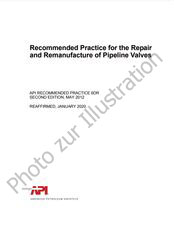Wir benötigen Ihre Einwilligung zur Verwendung der einzelnen Daten, damit Sie unter anderem Informationen zu Ihren Interessen einsehen können. Klicken Sie auf "OK", um Ihre Zustimmung zu erteilen.

API PUBL 4635-ed.1996
Compilation of Field Analytical Methods for Assessing Petroleum Product Releases
Name übersetzen
NORM herausgegeben am 1.12.1996
Informationen über die Norm:
Bezeichnung normen: API PUBL 4635-ed.1996
Ausgabedatum normen: 1.12.1996
SKU: NS-1139802
Zahl der Seiten: 98
Gewicht ca.: 325 g (0.72 Pfund)
Land: Amerikanische technische Norm
Kategorie: Technische Normen API
Die Annotation des Normtextes API PUBL 4635-ed.1996 :
API PUBL 4635, 1996 Edition, December 1996 - Compilation of Field Analytical Methods for Assessing Petroleum Product Releases
PURPOSE AND SCOPE
API intends to publish a series of documents to fill the gaps that now appear to exist in the application of certain field technologies for the analysis of petroleum hydrocarbon contamination, with specific emphasis on petroleum fuels, but with some potential application to heavier products and fractions of crude oil. Since fuels are best suited to field analyses, UST site assessments are the most appropriate. CERCLA (Superfund) and RCRA Corrective Action regulations, however, also allow for streamlined site assessments based on on-site analysis. The documents to be published, therefore, have applicability for all of the above and are intended to evolve as follows:
Phase I--A compilation of technical information and resources on various techniques, with summarized performance specifications and data quality classification.
Phase II--A decision tree on technology selection, QA/QC protocols for the field, a manual on how to optimize use in the field, and recommendations for training and record keeping.
Phase III--A field demonstration of data gathering, interpretation, and decision-making of a selected mix of technologies.
The purpose of this report is to compile technical and practical information on five selected field analytical methods for characterizing petroleum release sites (Phase I). The technologies selected are most frequently used in UST situations and are considered to be examples of mature techniques. These techniques have packaged equipment or kits that are available through several vendors on the market. In addition, another five were reviewed as emerging technologies that are developing but are not in widespread use or uniquely suited for petroleum fuel situations. This report is intended to summarize information on each of the five mature methods, which includes (1) data quality classification; (2) the compound(s) or indicator measured; (3) the achievable and practical detection or quantitation limit; (4) general QA/QC practices; and (5) interferences, limitations, and other practical considerations. The following field analytical methods are included in this report:
- • Total Organic Vapor (TOV) Detectors and Headspace Analysis
- • Field Gas Chromatographs
- • Immunoassay (IA) Field Test Kits
- • Portable Infrared Detectors, and
- • Dissolved Oxygen/Oxidation-Reduction Potential (DO/REDOX) Electrodes
This report provides a summary of these five field analytical methods currently being used by investigators. An overview of data quality classifications for these methods is presented in Section 2. This overview is intended to provide a general context for using the methods described in Sections 3 through 7. Section 8 provides an overview of new and emerging field analytical methods, without performance summaries.
Much of the information compiled on the different field analytical methods focuses on principles of operation and application. Each manufacturer and investigator may have developed his own specific variation on the instrumentation and procedure for a particular method. Therefore, this document, in combination with the manufacturers literature, will provide the best overall picture for potential users. This is reflected in the literature, which reports variable information for different procedures and instruments used for a particular method. Variations and performance information for different procedures, media, and instrumentation are reported where available.
Empfehlungen:
Aktualisierung der Gesetze
Wollen Sie sich sicher sein, dass Sie nur die gültigen technischen Vorschriften verwenden?
Wir bieten Ihnen Lösungen, damit Sie immer nur die gültigen (aktuellen) legislativen Vorschriften verwenden könnten.
Brauchen Sie mehr Informationen? Sehen Sie sich diese Seite an.



 Cookies
Cookies
